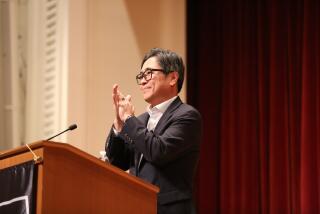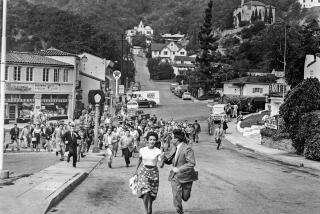Professor’s List Rounds Out the Well-Rounded : Data Zealot Uses Whole Earth Approach to Transmitting National Culture
CHARLOTTESVILLE, Va. — You have to know a thing or two to get along in the world, it’s true. But E. D. Hirsch Jr. thinks the number is closer to 5,000. What’s more--and what’s getting him a lot of attention these days--he’s prepared to tell you exactly what they are.
Open his book, “Cultural Literacy: What Every American Needs to Know” (Houghton Mifflin), to the fun part--the list at the back--and plunk your finger down somewhere:
- Crimean War.
- Critical mass.
- Cro-Magnon man.
- Crockett, Davy.
- Crocodile tears.
- Croesus, rich as.
Feeling culturally literate? Keep scanning the list.
- Empiricism.
- Empyrean.
- Encyclical.
- Endocrine.
- Enfant terrible.
- Engels.
If this exercise doesn’t draw a little trickle of uncertainty, you’re Hirsch’s kind of American: the “ideal common reader.”
On the other hand, if it begins to make you uneasy, you’re getting the message: People may still be learning to read and write, but those skills don’t matter much if the words draw a blank. U.S. schools, Hirsch contends, have abandoned their most essential function: the transmission of national culture.
His list is getting him a lot of ink and air time. Hirsch, professor of English at the University of Virginia, isn’t used to it, but it is fair to say he is adapting quickly.
Publicity Pipeline
A speech he delivered in San Francisco two weeks ago, to a convention of reporters who cover education, put Hirsch’s ideas about cultural literacy into the national publicity pipeline. The returns are already coming in: TV coverage, radio spots, magazine interviews and letters.
But his mission is influence, not celebrity, and coming from him, even the mission sounds modest. He wants nothing more--which is to say nothing less--from his fellow citizens than a capacity to say uh-huh confidently and convincingly in encounters with a Rorschach test, the Rosenberg case and Roses, War of the.
Not everyone says uh-huh to Hirsch’s method, however. The avowedly subjective genesis of his list--he and a couple of his colleagues, physicist James Trefil and historian Joseph Kett, consulted fellow professors for suggestions--has already prompted accusations of elitism. On another level, because to some the list smacks of “Trivial Pursuit” (Highbrow Edition), Hirsch has been faulted for fomenting a cult of dilettantism.
Useful at the Edges
He has a ready answer to the latter charge.
“If you take an educated person,” he says, “you will find at the edges of his or her information a lot of vague superficial knowledge, which is nonetheless extremely useful.”
Hirsch is pleased that he’s touched a nerve of national frustration with shoddy, mechanistic teaching. “I’m kind of like John Q. Public with particularly delicate antennae,” he says, placing his hands near his receding hairline and waggling his index fingers skyward.
The list, however, is only a device. It forms the appendix to a slender book that tries to make his case for educational reform.
In the years before World War I, “the literate culture was very effectively transmitted by the schools,” he says.
But the “skills-centered” learning and “cafeteria-style” curricula that have come to dominate educational theory for most of the last half-century ignored what Hirsch calls “the teaching of commonly shared, traditional information.”
Good Intentions
He concedes that these “wrong and pernicious ideas” were well-intentioned. “Most people didn’t realize that reading requires all this constructive activity that’s based on specific information. If (educational reformer John) Dewey had realized some of these basic facts . . . he would have adjusted his theories.”
As he told the education writers in San Francisco, “literacy can never be separated from the specific information that makes up literate culture.”
The list in his new book is only a rough draft. By this time next year Houghton Mifflin will have published a refined version, amplified as a full-fledged dictionary of cultural literacy, complete with brief need-to-know definitions.
“The dictionary is more ambitious and really more important,” Hirsch says, “because it will suggest to people who are outsiders in the literate culture, ‘What do these characters really know that I’m being excluded from?’ ”
Whatever you may think about the value of lists, the one in the appendix to “Cultural Literacy” is hard to resist.
Villains to Magicians
It is full of villains (Khomeini, Ruhollah), idioms (pop the question), medical nomenclature (hypothalamus), aphorisms (road to hell is paved with good intentions, The), bureaucratese (Federal Deposit Insurance Corporation), foreign terms (pro rata), places (Dien Bien Phu), legends in their own time (Mata Hari), legislation (Volstead Act), songs (“John Brown’s Body”), psychobabble (role conflict), slogans (“Remember the Maine!”) and magic (supply side).
As an alphabetical sequence, the list yields provocative combinations (Burr-Hamilton duel and bury the hatchet) and unlikely neighborhoods (Loyola, Saint Ignatius of, and Lucifer).
There are odd inclusions and omissions--Norman Mailer is on the list while Saul Bellow, Graham Greene and Vladimir Nabokov are not--but Hirsch seems to enjoy having them pointed out. George McGovern but not Hubert Humphrey? “He should be on there,” he concedes. Alger Hiss but not Whitaker Chambers? “What’s your feeling about that?”
Scientific Wish List
There’s one other thing about the list that worries Hirsch. The terms drawn from the humanities and social science spheres, he says, “describe what literate people tend to know.” Those from the natural sciences, on the other hand, are more wishful; they prescribe “what they should know.”
As Hirsch’s physicist colleague Trefil notes in the appendix, when he uses the word proton in a general-interest journal, he is bound to attach a brief definition. “If a political scientist were to proceed on comparable assumptions,” Trefil writes, “he or she would have to explain every time a term like ‘United States Senate’ appeared in the text.”
The list reflects the point Trefil makes. Even the most idealized common reader of 1987 is scientifically dimwitted, but Hirsch says “the public wants their children to be more literate scientifically than they are.” So he is prepared to include little-understood scientific terms and live with the resulting “intellectual untidiness” of the list.
One last question: How does he know the list is any good? Well, he consulted some lawyers. . . .
Hirsch and his collaborators sent a “representative sampling” of the list to 600 of them, making the rather bold assumption that “lawyers, by profession, are literate Americans,” and asked them to provide definitions. The average score was 92%, even on the scientific terms.
Whether anyone cheated, Hirsch will never know.
More to Read
Sign up for our Book Club newsletter
Get the latest news, events and more from the Los Angeles Times Book Club, and help us get L.A. reading and talking.
You may occasionally receive promotional content from the Los Angeles Times.









